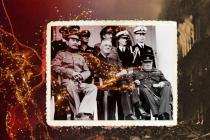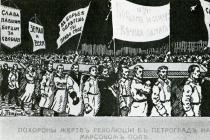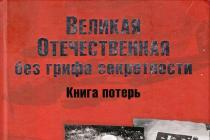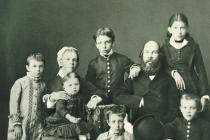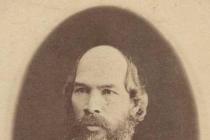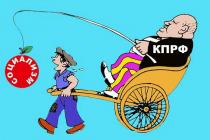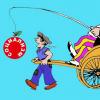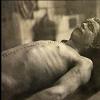Medical dates calendar
Chocolate is not only tasty, but also healthy!
On July 11, sweet lovers and all progressive humanity will celebrate World Chocolate Day, which was recently invented by the French in 1995. This young holiday quickly gained popularity. On July 11, large cities of Russia from Kaliningrad to Vladivostok also host festive events and festivals with a chocolate theme. “Russia is a generous soul” ... Living in Samara, we, of course, could not help but celebrate such a holiday.
Chocolate is one of the most ancient foods on our planet.

His homeland is Central America.
And what wonderful fruits this tree bears!
Oblong, in a variety of colors - from green to red, from yellow to purple - they grow straight from the trunks and branches!
They grow in a strange bouquet - at the same time ripe fruits and ovaries, delicately smelling flowers and even buds. As if you immediately see three times: childhood, youth and maturity.
It is not for nothing that chocolate is considered the elixir of eternal youth. The botanical name for the cocoa tree comes from the Greek words theos (god) and broma (food), as well as the Indian word cacao. Thus, cocoa is nothing more than the food of the gods. And the gods know a lot about food ...
The legend of chocolate

The wonderful tree, called the gentle May word Cocoa, did not always turn green in earthly gardens - only the Gods enjoyed the wonderful drink from its fruits ...
But one day a man was born who the stars were destined to become a great gardener. The gods themselves endowed the gardener - Cocoa began to grow in his gardens.
The strange, oblong fruits surprised the gardener - they tasted bitter, but they made an amazing drink that gave strength and delighted the heart. Soon people began to value this elixir worth its weight in gold, and cocoa beans were more desirable than hard coins. The gardener became rich and famous ...
And he became proud, and began to consider himself superior to all people, imagined himself equal to the gods. The gods were terribly angry - and deprived the ungrateful mind. And the mad gardener chopped up the gardens he once loved so much. But the divine cannot perish at the hands of a mere mortal - a single tree stood unharmed in the devastated garden. It remained in the world of people, and still gives them its amazing fruits. They make chocolate.
HISTORY OF CHOCOLATE: A JOURNEY FROM AGE TO AGE

Age of the Gods
Everything flows, everything changes - only the true remains the same.
Truth is in chocolate. Do you feel the Spirit of Chocolate?It is in every chocolate bar you eat for dessert, it is in every sip of a thick hot drink.
Once upon a time, in the Age of Gods, in Central America, an inspired priest rubbed cocoa beans and, on a whim, prepared a strange potion ... And the golden era of chocolate began. People drank it - and they were healthy, strong and happy!
The wheel turns a circle: history turns ...
But one day the Age of Gods ended. The great gods turned their backs on the Indians - they went to their luxurious palaces on top of the world. And when the strangers sailed, they were received with open arms, thinking that they were the messengers of the gods. And the last battle of the Aztecs came ...

Age of discovery
“For the Ruler! For Chocolatl! " shouted the Aztec warrior. And he fell, struck by a Spanish bullet.
Year 1517. Hernán Cortez, a crafty and cruel Spaniard, conquered all of Mexico. The Indians brought gold - it was not enough for him and his army, and they plundered all the new cities and villages. But the Aztecs had one more jewel - and Cortez tasted the chocolatl prepared by the priests. It was liquid magic! The Spaniards were eager to find out the secret recipe - they got it from Montezuma. Once a proud ruler paid a rich ransom - he filled the hall with gold and collected innumerable cocoa beans. But he was executed treacherously. This is how the last ruler of the Aztecs died.
The spears of the Indians against the rifles of the Spaniards is an unequal battle. The price is life. The reward is precious chocolate.
The Spaniards had in their hands a treasure never seen before in Europe. They covered it with mystery and blood: all the Indians who knew the recipe for chocolate were brutally killed. Valuable cocoa beans filled the holds of galleons and went home - to wealth and glory. And the drink of the gods arrived in Spain, destined to become the drink of kings. This is how the Spirit of Chocolate began a journey that would bring him the love of the whole world.

Age of Secrets
Cortez's ships entered the Spanish harbor.
The king himself received the general. With precious fragrant grains, Cortes bought forgiveness for his cruelty in America.Spain acquired a drink with unique, almost magical properties - it sharpened the senses, strengthened the spirit and cured diseases.
“Fear the holy Inquisition - she is following you. Fear the holy Inquisition, she will seize you - because the secret of the drink of kings has been revealed to you! "
Spaniards - hot-tempered and jealous - under fear death penalty guarded the recipe for an overseas drink. It was the secret elixir of the royal court, a privilege for the elite.
They could have killed and killed for him.But the Spirit of Chocolate could not languish locked up ...
And one day the European world turned upside down.

Age of intrigue
Spain could not hide the secret of this wonderful drink forever.
Rumors about him circulated throughout Europe throughout the 16th century. Secretive agents besieged the Spanish high society - information about chocolate was stolen and sold, they got caught on it, they died for it.
Meanwhile, the Spanish pastry chefs have worked hard on the Aztec drink. Chocolate was now boiled with sugar, delicate cinnamon and fragrant nutmeg. And it turned out ... divine! Differently than the Indians, but very tasty for the Europeans!Chocolate has become a real delicacy - albeit for a limited circle of wealthy lucky people.The Spaniards did not miss the opportunity to enrich themselves - they began to sell the ready-made drink to other countries. But the recipe was not disclosed. Chocolate kept its own secret. It was too expensive a pleasure - after all, it was transported from across the sea! And selfish officials also introduced a high tax on cocoa beans. And they received a lot of money! No wonder the historian Oviedo sadly remarked: “Only the rich and noble can afford to drink chocolate! Since he literally drinks money! "

Age of epiphanies
1615 violated the increased secrecy of the recipe.
King Louis XIII of France married the Spanish Infanta Anna of Austria. She was in love with chocolate and refused to go to France without this invigorating drink. And - without her young maid of honor Molina, who knew how to masterfully cook hot chocolate. The girl became the first culinary specialist in France - and selected chefs began to gather from all over the country. In order to comprehend the secrets of the chocolate art in the strictest secrecy and get imbued with the Spirit of chocolate!
While chocolate intrigues were brewing in Spain and France, and Europe was suffering without a wonderful drink, Francesco Carletti went for his dream.
He, an Italian traveler, was lucky enough to once drink a divine drink - and he fell under his spell. In search of the secret of chocolate, he crossed the ocean and reached America.
Carletti - to our happiness - did not disappear into obscurity, but returned to his homeland. Italy rejoiced! She fell in love with chocolate and, not afraid to experiment, made it a delicious treat. The Italians did not selfishly hide the miracle - they discovered many "chocolaterias". From here - from sunny and sociable Italy - the Spirit of Chocolate began its triumphal march across Europe. And then - all over the world. Good luck!

Age of Legends
XVII century, XVIII century. Hot chocolate is no longer a secret on a global scale, it is tasty and affordable, although not cheap. A cup of a fragrant drink is no longer exotic, but a sign of good taste in the high society of Europe. The consumption of chocolate in Europe was limited only to aristocratic circles. Eminent women considered chocolate to be an aphrodisiac. The famous physician Christopher Hoffman treated serious illnesses with chocolate, and many seriously considered the drink a panacea for all illnesses! And he also prolonged life ... But pregnant women were not advised to drink it: they were afraid that children would be born black! :)
Chocolate curiosity: devout Europeans were terribly worried - isn't it a sin to drink hot chocolate while fasting? The drink was brought to Pope Pius V for a sample. The answer was unexpected: “Chocolate does not break fasting in any way. Such filth cannot bring pleasure to someone! " And the whole point is in the bitterness, which the chefs deliberately did not beat off with sugar!

A century of experimentation
In 1659, David Schellu decided to follow in the footsteps of the original American recipe. Precious grains were sorted out and cleaned by hand, fried. They were rubbed with a huge roller, like the devices of the Aztecs, which had long since sunk into oblivion. Then all the necessary ingredients were mixed - and voila! - an enterprising Frenchman has achieved success! It was he who opened the world's first chocolate factory.
In 1819, a real chocolate revolution took place! Swiss Francois Louis Caye was able to get pure cocoa butter! Subtle calculation and amazing luck! Now you can not only drink chocolate, but also eat it! The usual tiled form appeared only in the middle of the 19th century. In 1828, the Dutchman Konrad van Houten patented a hydraulic press, with which it was possible to extract butter from cocoa beans. And in 1874 at the English firm "Fry and Sons" they learned how to mix this butter with cocoa powder and sugar. Soon there was a huge demand for new chocolate - in the form of bars. Then, thanks to the innovation of Daniel Peter, milk was added to the chocolate.
Only industrial production chocolate allowed to reduce the price of this product, which, of course, immediately affected the quality, but allowed people of lower classes to join the "food of the gods."
ARRIVAL OF CHOCOLATE IN RUSSIA

According to one version, Peter I brought chocolate along with coffee to Russia. At the same time, the court order “kofeshenok” appeared - the “caretaker” of coffee, tea and chocolate.
According to another, more believable version, chocolate appeared in Russia at the beginning of the 19th century, when a merchant sent a ship to New York, where, having profitably sold flax, hemp, iron and ship equipment, he acquired a valuable cargo - cocoa - and brought it to Russia. ...
At the end of the 19th century in St. Petersburg, hot chocolate was very popular among aristocrats: it was served to guests who arrived at the ball so that they would warm themselves after a long journey in a shaking carriage in the rain, slush or bitter frost.
It was rumored that Count Shuvalov himself brought this wonderful warming cocktail from England, the land of rains and progress.
Petersburg is the birthplace of Russian chocolate. In the 19th century, for the first time in Russia, the first artisanal chocolate production based on Swiss technology was established.
However, Muscovites dispute this primacy. After all, at about the same time, the production of chocolate bars appeared in Moscow, which, however, was under the control of foreigners.
INTERESTING FACTS ABOUT CHOCOLATE

1. Chocolate contains substances called flavonoids. As it turned out, this substance is able to support the normal functioning of the heart and blood circulation due to its ability to destroy blood clots, which become the causes of heart attacks and other diseases associated with poor circulation.
2. Cocoa reduces the production of cholesterol, an increased amount of which is harmful to the heart and blood vessels.
3. Chocolate is a natural energy drink (it helps to increase physical and mental activity).
4. Cocoa beans and products made from them (dark dark chocolate) are useful, first of all, because they contain a large amount of strong antioxidants (prevent the appearance of free radicals, slow down the aging process of body cells, stimulate the production of endorphins, "pleasure hormones").
5. Cocoa beans - the richest source of biologically active substances (vitamins: B1, B2, PP, provitamin A; trace elements: calcium, iron, potassium, magnesium, sodium; theobromine, phenylethylamine, plant proteins, phytosterols, flavonoids).
6. Consuming chocolate reduces the likelihood of occurrence oncological diseases, stomach ulcers, hay fever and strengthens the body's immunity.
7. Dark chocolates stimulate the release of endorphins - hormones of happiness that affect the pleasure center, improve mood and maintain body tone, but recent studies have shown that chocolate can aggravate disorders in those who are stressed or depressed
8. Research by Finnish scientists has shown that chocolate lovers give birth to happy children.
9. Chocolate helps women with premenstrual syndrome (PMS). This is due to the magnesium content in chocolate, the lack of which exacerbates PMS.
10. Scientists claim that chocolate can be classified as a health food. Chocolate is not just a delicacy, but also a healthy food product.
11. But what scientists are unanimous about is the denial of the ability of chocolate to reduce body weight! It's well known that chocolate is rich nutrients, including fats, and therefore calories.
12. Chocolate is loved most in Switzerland: the average inhabitant of this country eats more than 10 kg. chocolate a year!
And yet, many consider it harmful.
The most common "horror stories" about chocolate.

There is too much caffeine in chocolate
In fact, an average chocolate bar contains only about 30 mg of caffeine, while a cup of coffee contains at least 180 mg.
Chocolate is very high in calories
This is also a myth. Energy value one large tile is only 300-450 kcal. And such a tile is not easy to eat alone.
Consuming chocolate leads to acne on the skin
American doctors have proven otherwise. Over the course of several weeks, they fed massive amounts of chocolate to several dozen teenagers. At the same time, half of the subjects received real chocolate, and the other - a surrogate that did not differ from the real one either in taste or in color. There were no acne in either case. Doctors came to the conclusion that their appearance is an individual reaction of the body to various supplements.
Chocolate destroys tooth enamel
Any sweets have a destructive effect on the teeth. To neutralize it, it is necessary after sweet food brush your teeth.
And in chocolate, an antiseptic substance was found that suppresses the activity of bacteria that form tartar. Researchers at the University of Massachusetts Institute of Technology added cocoa powder to animal food and concluded that not only does it not cause tooth decay, it also slows down the progression of the disease!
Chocolate contains a lot of cholesterol
This is not true. After all, it is made from cocoa, which is herbal product, and cholesterol is found only in animal products. Therefore, it can only be present in milk chocolate, and then in very small quantities.
Chocolate causes constipation
In fact, this delicacy can have a laxative effect. After all, it contains tannin - a substance that regulates the intestines and promotes the removal of waste from the body.
There are no nutrients in chocolate
It is not true! Some varieties contain vitamins of group A and B, as well as iron, calcium and potassium necessary for the body. Moreover, chocolate is rich in magnesium. That is why, after eating a tile, we feel a sharp rise in mood. Caffeine, theobromine, and tryptophan lead nervous system in tone, and one of the amino acids contributes to the production of serotonin, the so-called "hormone of happiness".
But that is not all...
American doctors have come to the conclusion that the cocoa beans, from which chocolate is made, contain phenol, which helps to strengthen the walls of blood vessels. This reduces the risk of developing cardiovascular and kidney disease, type II diabetes, and even dementia!

We urge you to enjoy chocolate for your health ...
Sweet tooth, congratulations to Us!

World Chocolate Day is a young holiday - it was invented by the French and was first celebrated 23 years ago.
Popularity World day chocolate grows every year - today it is celebrated in many countries of the world, including Germany, Switzerland, Italy and Russia.
According to legend, the homeland of the delicacy is South America - for the first time chocolate was brought to Europe by Spanish conquerors and named chocolate "black gold".
The history of the discovery of delicacies
This ancient drink appeared about three thousand years ago - in those distant times, chocolate was made from cocoa beans and consumed hot. The Olmec Indians were the first to make chocolate - they once lived in what is now Mexico.
The tradition of making chocolate later became part of the Mayan culture - they called the drink divine. The recipe was simple - Mayan roasted beans were ground and mixed with water. They added special spices, such as pepper, to chocolate that was consumed cold.
In Mayan times, only a select few could drink chocolate, since it was considered sacred - they prayed and brought sacrifices to the god of cocoa Ek Chuakha.
The Aztecs, whose state existed on the territory of modern Mexico in the XII-XIV centuries, having conquered neighboring tribes, collected tribute from them, including cocoa beans, which were used to make chocolate and as a bargaining chip.
According to legend, the Aztec leader Montezuma was very fond of the delicacy made from the fruit of the cocoa tree - he drank 50 small cups of this drink every day.
The ancient Indians called the drink chocolatl (from choco - "foam" and latl - "water"). Chocolatl was served in gold glasses, adorned with precious stones. Perhaps where the modern name of the delicacy came from.
Thanks to the Spaniards, chocolate appeared in Europe in the XIV century - they were the first to appreciate the delicacy. The Spaniards believed that the divine drink not only strengthens strength, but also promotes rapid healing of wounds.
The Spaniards changed the recipe for the drink - they added sugar, nutmeg and cinnamon to the chocolate, making it more delicious. In those distant times, chocolate in Spain could only be afforded by a select few, those who could pay for it, since huge taxes were immediately imposed on cocoa beans.
France learned the taste of chocolate in 1615, after the marriage between Louis XIII and the Spanish Infanta Anna of Austria. Meanwhile, chocolate gradually conquered all of Europe - a fashionable drink was drunk in expensive coffee houses and in all aristocratic houses. Accordingly, the delicacy was an expensive pleasure that only rich people could afford.
© Sputnik / Alexander Imedashvili
Until the beginning of the 19th century, chocolate was consumed exclusively in liquid form - the world's first solid chocolate bar in 1819 was created by the Swiss Francois Louis Cayet.
And chocolate became available to the general population only at the beginning of the 20th century, when it began to be produced in large volumes. Chocolate is now a delicacy, without which many inhabitants of our planet cannot imagine their lives.
World chocolate day
In each country, World Chocolate Day is celebrated in its own way - various competitions, exhibitions and fairs, master classes and tastings and so on are dedicated to the delicacy.
On the holiday, large supermarkets and confectionery factories hold mass events - on World Chocolate Day visitors are shown how masterpieces from everyone's favorite delicacy are born.
Restaurants and cafes offer a gorgeous chocolate menu - chocolate surprises await visitors on this day.

© photo: Sputnik / Ruslan Krivobok
On World Chocolate Day, you can ride the "chocolate train" in Switzerland, and visit real chocolate museums in Belgium. The chocoland was built in Germany, where a show of the world's most delicious delicacy is staged for visitors.
Americans are real sweet tooth - they celebrate the chocolate festival twice a year.
The World Chocolate Day is celebrated on a grand scale and the Russians - the only monument in the world to the favorite delicacy of children and adults - the Bronze Fairy, flaunts in the Pokrov. The three-meter-high statue is installed next to the Chocolate Museum in Pokrov - on holidays it is always full of tourists.
Eating treats on World Chocolate Day is a traditional activity, but chocolate body art is considered the main entertainment - with the help of liquid chocolate and a brush, real masterpieces are created on the face and body.

© photo: Sputnik / Andrey Alexandrov
Chocolate has great cosmetic properties, which is why chocolate baths are also popular.
Chocolate festivals take place in many cities around the world, including Paris, Turin, Bruges, London, Dublin and Amsterdam, although their dates do not always coincide with World Chocolate Day.
During the festivals, visitors can taste all kinds of chocolate, visit the chocolate spa, stay in a chocolate hotel, or simply stroll through the chocolate park.
World Chocolate Day is a celebration of confectioners, artists who design candy wrappers, sweet tooth and all chocolate lovers.
Chocolate is not only tasty, but also very healthy - science has established that the delicacy contains elements that contribute to psychological recovery and relaxation.
At the same time, studies have shown that dark chocolate is much more beneficial for human health than milk and other varieties. For example, dark chocolate stimulates the release of happiness hormones - endorphins, which, acting on the pleasure center, improve mood and maintain body tone.
© photo: Sputnik / Ivan Rudnev
"Amazon fights" in chocolate in Minsk
Dark chocolate, according to scientists, helps improve vision and helps lower blood pressure. By increasing blood flow to the brain, it also improves alertness, memory, reaction speed, and problem-solving skills.
Chocolate is good for the heart - the risk of heart disease in people who regularly consume chocolate is reduced by 37%. It also reduces the risk of heart attacks in men by 17%.
People who eat a lot of chocolate are less likely to suffer from dementia in old age.
Melting chocolate in a person's mouth can lead to a more lasting euphoric effect than kissing.

© photo: Sputnik / Igor Zarembo
Crown made of chocolate and marzipan from the collection "Nikolya Chocolate Museum"
Chocolate is hypothesized to have an "anti-cancer" effect. It also slows down the aging process, pundits say.
And by regularly eating chocolate, we add a year to our life, so enjoy the treat and live long!
Material prepared on the basis of open sources
July 11 is World Chocolate Day. The first to learn to make chocolate were the Aztecs, who called it "food of the gods." The Spanish conquistadors christened the delicacy "black gold" and ate them to strengthen endurance. In the Middle Ages, the consumption of chocolate in Europe was available only to aristocrats.
Today, July 11, all sweet tooths celebrate a delicious holiday - World Chocolate Day.
This holiday originated in France in 1995. Chocolate Day quickly gained popularity and was supported in Germany, Italy, Switzerland and, in particular, in Ukraine.
Why is chocolate useful?
Science has established the fact that chocolate contains elements that promote both relaxation and psychological recovery. Dark chocolates help release endorphins, the so-called happiness hormones, which act on pleasure centers to improve mood and tone the body.
There is also a hypothesis that chocolate has an "anti-cancer" effect and is able to slow down the aging process.
At the same time, scientists unanimously state the fact that chocolate contributes to an increase in body weight, but this is by no means a drawback. Chocolate is rich in nutrients, including fat and therefore calories.
It is believed that the Aztecs were the first to learn how to make chocolate. The main raw materials for the production of chocolate are cocoa beans.
During recent years A number of world media outlets report that eating chocolate is good for the heart, helps prevent cancer and improves mood. There is a hypothesis that chocolate can slow down the aging process. But is it really so?
Ulyana Suprun on her page in Facebook told what useful properties possesses chocolate, how to use and choose it correctly. Suprun said that the most beneficial is dark chocolate with the maximum content of cocoa beans. If this delicacy does not contain sugar, then it has anti-inflammatory, cardioprotective, anti-allergic, anti-hepatotoxic effects.
Milk chocolate with additives does not have any beneficial properties, but just the opposite, the expert wrote. Suprun also told how chocolate is made:
Cocoa beans are fermented by bacteria and fungi to create their aroma. Refined and dried cocoa beans, rich in polyphenolic compounds and butter. Then the cocoa beans are fried, cleaned, made liquid cocoa, from which butter is squeezed out. Cocoa powder may have different cocoa butter content depending on how it was pressed. Sometimes liquid cocoa is alkalized (called the Dutch process) to make it less acidic. Chocolate is made from liquid cocoa or cocoa powder and cocoa butter and emulsifiers.

The benefits of dark chocolate:
Vasodilation
The flavonols of cocoa and dark chocolate contribute to the formation of nitric oxide. This compound dilates blood vessels and reduces pressure. Thus, chocolate makes a significant contribution to the prevention or control of the progression of diseases associated with inflammation, and somewhat reduces pressure.
Antioxidant action
Cocoa and chocolate contain polyphenolic compounds that trap and quench free radicals and inhibit enzymes involved in peroxidation. Simply put, these substances prevent our molecules from deteriorating from bombardment with highly reactive compounds.
Cholesterol balance
In one experiment, after 7 days of consuming dark chocolate, people had a 6% decrease in their "bad cholesterol" levels and a 9% increase in their "good cholesterol" levels. Similar results have been found in other studies, including among people with type 2 diabetes.
Blood supply to the brain
Cocoa and chocolate can be beneficial for people with dementia, Alzheimer's disease, and those who have had a stroke. They also improve brain function, alertness and memory. If you don't get enough sleep, chocolate and cocoa will help you rejuvenate.
Intestinal microflora
Cocoa polyphenols have a fairly low bioavailability, so only a fraction of the consumed substances will get from the intestines into the blood. However, the positive effects of cocoa and dark chocolate are fairly obvious.
Photoprotection of the skin
Regular consumption of dark chocolate or cocoa reduces the appearance of redness, inflammation and free radical processes, as well as improves blood circulation in the skin and the formation of collagen.
Suprun warned that children should not eat chocolate, because sweets are a threat to the teeth, and extra calories instead of a full meal. But do not forget that the flavonoids contained in cocoa beans have a beneficial effect on the state of the intestinal immune system and prevent food allergies.
Contrary to the myth that chocolate and citrus fruits cause allergies, this is not true. What is mistaken for an allergy in a child is atopic or systemic contact dermatitis. Food allergies manifest as abdominal pain, itchy mouth, or diarrhea. Dermatitis is indeed often accompanied by and food allergiesso sometimes they are the same. But the most common food allergens are dairy products, nuts, or eggs, but not cocoa.
True sweet tooths will always find a reason to feast onfavorite sweets... But there is a special day when chocolate becomes the center of everyone's attention and can be eaten by the sea without worrying about extra calories.
This day is not loved by everyone New Year or your own birthday. The sweetest, most delicious, favorite holiday for the sweet tooth became Chocolate Day, which is celebrated all over the world on July 11.
# When is World Chocolate Day celebrated: the history of the holiday
|
|
The celebration of chocolate is quite young. It appeared quite recently - in 1995.
The initiators of the chocolate day were french people, who are rightfully considered to be connoisseurs of chocolate.
But there is no explanation for the choice of the date for the celebration of World Chocolate Day.
Probably, summer, warmth, which is important for growing chocolate trees, played a role in choosing the date.
A year later, lovers of the divine dessert from Europe and America joined the French.
And the Americans liked the sweet idea so much that they now celebrate chocolate on October 28 and July 7 as well.
Chocolate Day in Russia and other post-Soviet countries is also celebrated in accordance with the international calendar on July 11.
#The history of chocolate
|
Why did chocolate become a universal, almost world favorite, to such an extent that its admirers came up with original holiday Chocolate Day.
The ancient delicacy has earned attention not only for its taste, but also for its centuries-old history.
The first chocolate desserts appeared several millennia ago and were served as drinks.
Such a treat was called "food of the gods" and was invented by the Mayan Indians, Aztecs.
Prepare " divine drink»From the beans of the cocoa tree, which grows only near the equator. The hot and humid climate of Ghana, Brazil, Malaysia is the most suitable for growing cocoa trees. The botanical name sounds like Theobroma cacao, which translates from Greek as the God (theos) and food (broma). So not only the Indians of the ancient tribes of the Aztecs and Mayans called chocolate "divine food".
|
Cocoa plantations date back to the 6th century. The Maya Indians living in the territories of modern Mexico considered the plant sacred, and the drink made from its beans as medicinal.
They not only worshiped cocoa, but also prayed to its god, believing in strengthening and miraculous power.
Later, the Maya beliefs were adopted by the Aztecs, who conquered these lands.
For their leader Montezuma, the drink became so favorite that he could drink up to fifty cups of a bitter delicacy in a day.
|
The first European to taste an unusual delicacy was Columbus, who was treated to chocolate by the Indians in 1502 as a sign of hospitality. But the bitterness of the drink did not suit him, and he refused the treat.
Appreciated chocolate at the merits of Cortez, who landed on the shores of Mexico in 1519.
To soften the bitterness, white guests began to add cane sugar to the drink.
Having delivered the beans to Europe, the Spaniards came up with improved recipes for chocolate with the addition of cinnamon, sugar, nutmeg. The drink received a new name " Black gold».
|
This nickname was associated not only with taste.
The price for a cup of chocolate drink was really fabulous.
Only noble people could taste it, who purposefully visited Spain for this.
The recipe was kept secret for a long time.
But the Spaniards could not save the Black Gold recipe.
Thanks to smugglers, by the end of the 16th century, it ends up in Italy, and from there to other European countries.
An important role in the prevalence of chocolate was played by Anna of Austria, who, having arrived in France as the wife of Louis XIII, brought with her several boxes of unusual beans.
Her personal chocolatier brewed an amazing drink, which was appreciated not only by the king of France, but also by the courtiers.
The popularity of the drink quickly reached incredible heights, surpassing the French love for tea and coffee.

It was in France that a flock of specialized chocolate cafes opened, of which there were more than 500 by the middle of the 18th century. But the drink remained the prerogative of the rich and noble for a long time.
Chocolate was considered not just a delicious delicacy, but also a healing one. Chocolatiers came up with their own unique recipes, and for Louis XVI, the master of chocolate prepared a drink with the addition of medicinal herbs, flower petals, essential oils.
The British were the first to think of adding milk to chocolate in the 18th century. It was a real revolutionary breakthrough among pastry chefs.
But in Belgium, pharmacists began to cook chocolate as a healing potion. Until the middle of the 19th century, chocolate dessert was prepared only in liquid form.
The British, after inventing a method to extract oil from beans, presented the world with the first bar of chocolate.
Milk chocolate began to be prepared in Switzerland only in 1875. But these delicacies remained inaccessible to the common people. It wasn't until 1930 that the world saw white chocolate.

For a long time, the delicacy was associated with bourgeois vestiges, which was explained by its high cost.
The merchant Abrikosov, who was able to create the production of chocolate, is considered a domestic discoverer.
His factory produced funny candies in bright wrappers and collectible sets. He owns the idea of \u200b\u200bchocolate Santa Claus and hares, as well as the recipe for "Duck Noses" and "Crow's Feet", "Crayfish Necks".
|
The national delicacy appeared only in 1965, when the production of chocolate was established on an industrial scale.
The famous "Alenka" has become a national chocolate, which has not lost its popularity today.
It is produced by many confectionery factories, but the name has practically remained the original. In Ukraine you can meet "Olenka", and in Belarus "Favorite Alenka".
Today, chocolate is the collective name for confectionery made from cocoa and sugar products.
The recipes use many different ingredients in the form of whole or chopped nuts, milk powder, cream, fruits, raisins, and other confectionery additives.
|
On Chocolate Day, many factories have an open day.
This is a great opportunity to see with your own eyes how cocoa powder, milk and delicious additives turn into a favorite delicacy of the most bizarre forms.
Factories not only arrange tastings, but also allow guests to participate in the process of preparing desserts.
In Russia, three museums have been opened in honor of chocolate, which are located in the capitals and in the city of Pokrov. There is also a monument to the chocolate bar - "Bronze Fairy", and in 2009 the largest celebration was held.
They try to hold the chocolate festival in large and small cities on a large scale.
In honor of your favorite delicacy, unusual and exciting events are organized.
Fairs are organized where you can buy unusual treats or show people your desserts.
And in Ukraine in 2014, a chocolate festival was held, at which, in addition to the traditional fair and performances of chocolatiers, sculptors, a confectionery championship was held.
An unusual entertainment was invented for the kids, which made it possible to assemble a steam locomotive from chocolate wagons, which set off on a journey through a real chocolate country.
In Switzerland, in honor of the holiday, you can ride the chocolate train. On an extraordinary journey, you can learn about the history of Swiss chocolate.
|
In all coffee houses of the world, on this day, the menu must include chocolate treats, or even small surprises for visitors.
# Happy Birthday chocolate: how to spend your chocolate day?
The opinion about chocolate as a “sweet drug” is not unfounded, because chocolate is indeed addictive and addictive.
Chocolate contains antioxidants that can fight aging and resist cancer.
Chocolate can reduce pain.
Everyone knows the ability of dark chocolate to stimulate the synthesis of endorphins.
Happiness hormones act on pleasure centers to improve mood and psychological well-being.
|
Of course, no one has come up with an effective chocolate diet yet.
The delicacy is rich in fats, which undoubtedly affects its calorie content.
But knowing when to stop, you can enjoy healthy and tasty chocolate with pleasure, without worrying about the consequences on the sides.
And on the day of chocolate, giving up your favorite treat is simply stupid.
There are many ideas on how to spend a chocolate holiday.
The most common option is chocolate party or party.
Invite your friends with a sweet tooth or organize a party for children.
Of course, sweets, cakes, drinks, desserts will be used as treats.
Chocolate must be present everywhere. Make the chocolate fountain or chocolate fondue the center of the party.
Do not forget to congratulate your friends and relatives on Chocolate Day, whose professional activity associated with the production of the famous delicacy.
And just to friends, children, beloved girl it will be useful to give small chocolate gifts.
#Interesting Factsassociated with chocolate
|
|
Those with a sweet tooth probably know about Chocolate Day, which is celebrated annually at the height of summer - July 11. The idea of \u200b\u200bthe celebration belongs to the French: they are big fans of the exquisite delicacy. Since 1995, the holiday has been considered national, but over time, other countries have adopted a similar tradition.
Due to the huge popularity of such an event, the World Chocolate Day began to be celebrated four times a year: September 2 and 13, June 9 and traditionally July 11. The Americans, who gave the holiday the name World Chocolate Day, dedicated 2 more days to their favorite delicacy: October 28 and July 7. So the sweet tooth has a reason to taste chocolate and participate in entertaining contests and festivals as many as 6 times a year.
How did chocolate appear
The history of chocolate dates back to 1000 BC when the natives Latin America (the Olmec tribe) first drew attention to the fruits of the chocolate tree. It is believed that chocolate is a derivative of xocolātl. Among the ancient aborigines, this word meant "bitter water". The fact is that the delicacy was originally consumed only in liquid form, with the addition of hot pepper and sweet corn grains. Cocoa was mixed with these unusual ingredients, whipped in water until foam appeared, and drank only when the drink began to ferment. It is noteworthy that only the leaders were allowed to use it. Women, children and commoners had no right to touch the divine nectar. The same traditions were among the Maya and Aztecs. They even worshiped a cocoa god named Ek-Chuakh.

Mayan cocoa god Ek Chuah
The first European to taste an overseas delicacy was the navigator Columbus. Unfortunately, he could not appreciate the cold and spicy drink, so he gave the grains to the American Indians. The fruits of the chocolate tree came to Spain in the 16th century thanks to Cortez, the conquistador who conquered Mexico. Having defeated the Aztecs, he became the owner of unique cocoa plantations and established supplies throughout Europe. Spanish monks and hidalgo, who were engaged in the preparation of the dessert, changed the recipe, eliminating pepper and spices and adding sugar. Thanks to this, the drink became sweet and pleasant to the taste, moreover, it was served hot.
In the Middle Ages, dessert was literally worth its weight in gold due to high taxes and production difficulties. In France, they got acquainted with the delicacy thanks to Louis' wife, Anna of Austria. The British and Germans immediately picked up fashion trend... Chocolate became an exquisite dessert for nobles and dignitaries, and chocolate houses soon filled all the streets of Paris and London.

In 1847, British pastry chef Frye made a revolutionary discovery: he added cocoa butter to the dessert, which caused the chocolate to freeze and harden. This is how the first slab chocolate was born. Since the middle of the 19th century, the largest factories in the world began to produce a new confectionery product: the English Cadbury (famous for the Wispa and Picnic bars), the Swiss Nestle (which was originally focused on the production of artificial milk formulas for babies), the Russian Einem (which was later renamed to Red October"). Today there are a huge number of both large companies and individual manufacturers of hand made products. World Chocolate Day has become a testament to the popularity of this confection throughout the world and among all peoples and generations.
Features of the celebration
World Chocolate Day is celebrated on all continents and in almost all countries: Russia, USA, France, Germany, Spain, Great Britain, Switzerland, etc. body, chocolate baths, theme fairs and exhibitions.
Those who are lucky enough to visit Switzerland on July 11 are advised to take a ride on the "chocolate train". During the trip, the guide tells the amazing story of the origin and development of the dessert.

Belgium is famous for its unique chocolate museum, and the Germans created "Chocolandia" - a paradise for those with a sweet tooth. Tourists are invited to visit interesting shows and take part in master classes and tastings.
Russian confectioners also keep up with their foreign counterparts. In 2009, the first Russian monument to chocolate called "Bronze Fairy" was unveiled in Pokrov. The 3-meter-high statue is installed next to the chocolate museum. On the day of the celebration, tourists and visitors will enjoy an exciting show program and many interesting contests.
The holiday of chocolate is an excellent occasion to congratulate relatives and friends who participate in the creation of their favorite delicacy: they work in confectionery factories or are engaged in the design of wrappers. It is not necessary to go to Pokrov or to Europe; you can organize your leisure time on your own with your family. Adults can be pampered with a chocolate fondue with liqueur, while children can be pampered with bars, cakes, ice cream or fruit salads. Songs of domestic performers on a given theme will be appropriate as musical background: "Chocolate Bunny" by Pierre Narcissus, "Coffee and Chocolate" by Inna Malikova, "Mulatto Chocolate" by Dima Bilan. A creative and creative approach will allow you to create a festive atmosphere and introduce a new family tradition of celebrating the day of your favorite delicacy.

Did you know?
Chocolate is not only delicious, but also a very healthy dessert. When used in moderation, it stabilizes blood pressure, normalizes heart function and has a beneficial effect on the nervous system. Just one slice improves mood and helps fight depression.
The most useful is dark chocolate with a high content of cocoa beans (over 70%). It improves vision, memory, reaction speed, reduces the risk of stroke and heart attack, cancer, strengthens the immune system. Scientists have shown that people who consume a cocoa product, if not every day, then quite regularly, the risk of cardiovascular disease is reduced by 37%.
Chocolate is also a great aphrodisiac as it increases libido. The feeling of melting in the mouth plunges the person into a prolonged state of euphoria, which is comparable to a kiss. Due to the regular use of this confection, women experience more satisfaction and attraction, which significantly improves the quality of their sex life.
Chocolate in numbers
- The lifespan of chocolate trees is 200 years, of which only 25 are fruitful.
- There are 300 varieties of cocoa beans and 400 different flavors in the world.
- The Swiss are the record-holders for eating sweets. Each of them, according to statistics, eats 11.8 kg of chocolate annually.
- made by the British. Its weight is 5.8 tons.









